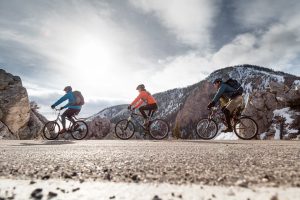Yellowstone Opens to Cyclists Friday, April 7 (But Look Out for “Hungry Traffic”)
Written by Andrew-Rossi on April 6, 2023
Certain roads and road segments in Yellowstone National Park will be accessible for eager cyclists – but hungry, stressed animals using the same roads have the right-of-way.
Beginning Friday, April 7, bicyclists willing to brave the unpredictable weather of spring in Yellowstone National Park can ride 49 miles between the West Entrance in West Yellowstone, Montana, and Mammoth Hot Springs.
The following roads between the West Entrance and Mammoth Hot Springs will open to bicycling:
- West Entrance to Madison Junction
- Madison Junction to Norris Junction
- Norris Junction to Mammoth Hot Springs
As conditions allow, bicycles will also be permitted to enter through the East Entrance. Cyclists can ride six miles to the east end of Sylvan Pass.
Bicycles are not allowed on the remaining park roads until they open to public automobiles at 8 a.m. Friday, April 21. Check park roads for spring opening dates.
However, the right-of-way on Yellowstone’s roads goes to the park’s wildlife.
After a severe winter of above-average snowpack and continued cold temperatures, the park’s bears, bison, elk, moose, and other wildlife are stressed and weak. Furthermore, April is (historically) the hardest part of the year for large wildlife in the Greater Yellowstone Ecosystem.
Once the roads are clear, animals use roads as travel corridors when the snow is deep. Higher than usual snowbanks prevent them from easily moving off the road.

Courtesy National Park Service
Cyclists entering Yellowstone are asked not to crowd or push wildlife and be prepared to wait or turn around.
- Stay at least 100 yards away from bears and wolves and 25 yards away from all other wildlife.
- Carry bear spray and know how to use it.
- Travel during daylight hours only.
- Ride single file and use extreme caution.
- Expect administrative vehicles such as snowplows, heavy equipment, and contractor and employee traffic.
- Roadway shoulders are narrow, and curves can limit visibility.
- Watch for quickly changing weather conditions and the possibility of temporary road closures. Snow and ice may cover sections of the road.
- No services will be available except for limited restrooms.
- If you are lost or experience mechanical issues, plan for self-rescue or repair.
- Cell phone coverage throughout the park is sparse and unreliable for communicating emergencies.
- Prepare to spend an extended period in winter conditions in the event of a mechanical breakdown, injury, or other emergencies.
Check Yellowstone National Park’s biking web page for updates.

